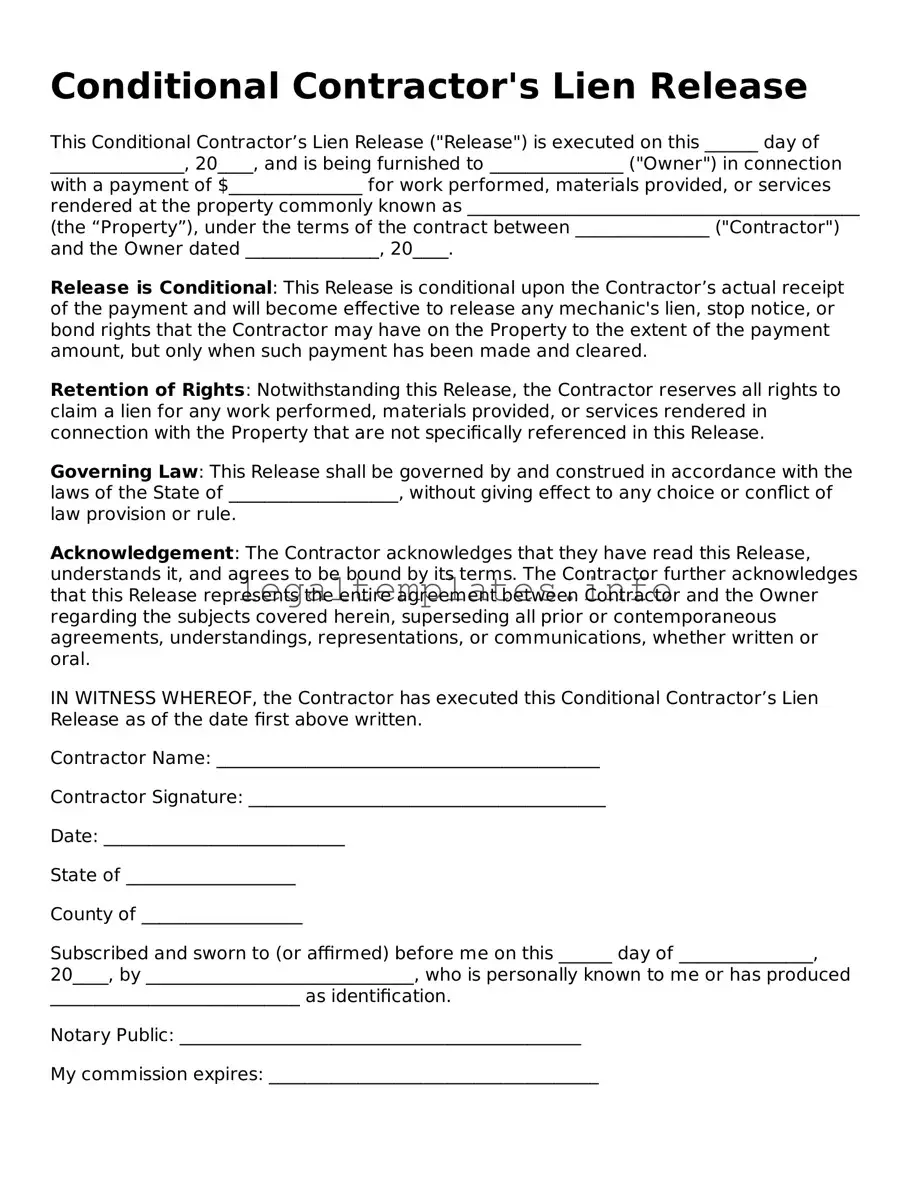What is a Conditional Contractor’s Lien Release form?
A Conditional Contractor’s Lien Release form is a legal document used in the construction industry. It indicates that a contractor or supplier will relinquish their right to file a lien against a property, on the condition that they receive payment for their work or materials supplied. This form ensures that the property owner is protected from potential liens, provided the agreed payments are made.
When should a Conditional Contractor’s Lien Release form be used?
This form should be utilized any time a contractor or supplier has completed work but has not yet been paid. It is typically requested by property owners or general contractors before releasing the final payment, to ensure that no liens will be placed on the property after payment is disbursed.
What makes the lien release "conditional"?
The term "conditional" refers to the provision that the lien release is only effective upon the receipt of payment. If the contractor does not receive the payment as specified in the agreement, the contractor retains the right to file a lien against the property.
How does a Conditional Contractor’s Lien Release form protect property owners?
It protects property owners by providing a formal agreement that contractors or suppliers will not file a lien as long as the terms stated in the release are met. This means that once the payment is made under the conditions specified, the contractor waives their right to claim a lien, ensuring a clear title for the property owner.
What information is needed to complete a Conditional Contractor’s Lien Release form?
Typically, it requires the property description, the name and address of the property owner, the contractor’s details, the amount to be paid, and the condition under which the lien will be released, usually the receipt of payment. It may also require notarization depending on state laws.
Can a Conditional Contractor’s Lien Release form be revoked?
Once the contractor receives payment, the lien release becomes irrevocable, meaning the contractor cannot then decide to place a lien on the property for that particular scope of work. However, if the contractor does not receive the specified payment, the conditional nature of the document allows for the filing of a lien if necessary.
Is a Conditional Contractor’s Lien Release the same as a final lien waiver?
No, a Conditional Contractor’s Lien Release is used before payment is made, specifying that the release of lien rights is dependent on receiving payment. A final lien waiver is used after payment has been received, providing proof that the contractor has no further lien rights for the amount paid.
Does a Conditional Contractor’s Lien Release need to be filed with the county recorder's office?
This document does not typically need to be filed with the county recorder's office. It is a private agreement between the property owner and the contractor. However, retaining a copy of the signed and, if applicable, notarized form in your records is highly recommended for both parties.
Who should hold onto the Conditional Contractor’s Lien Release form after it's signed?
Both the property owner and the contractor should keep a signed copy of the form. This ensures that both parties have proof of the agreement that the contractor will not file a lien once payment is received according to the terms of the release.
How can disputes over payment be resolved after a Conditional Contractor’s Lien Release form is signed?
If a dispute arises over payment after the form is signed, but before payment is fully processed, parties should refer to the terms outlined in the agreement. Mediation or legal advice may be sought to resolve the dispute. The conditional nature of the document allows for legal recourse in case the agreed payment is not made as specified.
